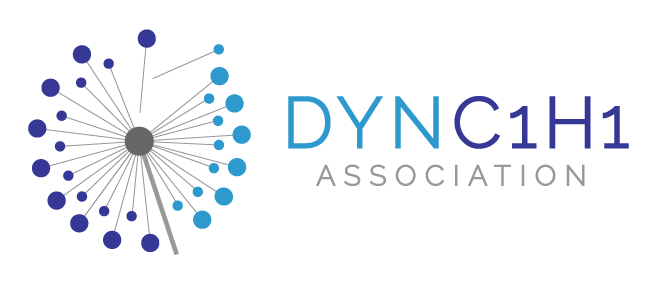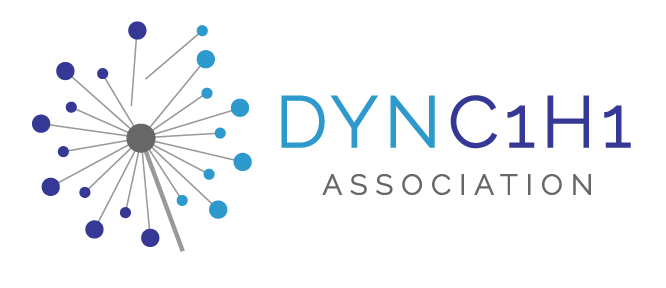Case Study: Bone Cancer in a Teen with a DYNC1H1-Related Disorder
In January 2025, Dr. Paul D’Alessandro and his team published a thorough case study of an osteosarcoma in a DYNC1H1 patient. The Letter to the Editor, published in the journal Pediatric Blood & Cancer, presents the case of a teenager with a DYNC1H1-related disorder gene who developed osteosarcoma—a type of bone cancer. It is the first known case of its kind. This discovery might help caregivers and doctors better care for others with DYNC1H1-related conditions by paying closer attention to possible signs of cancer. If you or your loved one with a DYNC1H1-related disorder has experienced cancer, please reach out to us so that we can continue to build on this knowledge, as well as offer support.
What is DYNC1H1 and Why Does it Matter in Cancer?
The DYNC1H1 gene helps the body make a protein called dynein. Dynein is a tiny motor that helps move important materials inside cells. It also plays a big role when cells divide and make new cells (a process called mitosis). Cancer is caused by cells growing and/or dividing too quickly. Genes within cancer cells are either turned on, causing cells to divide uncontrollably, or fail to turn off, which also leads to unchecked cell division. Altered expression of the DYNC1H1 gene, which may cause changes in dynein’s activity, has been reported in various types of cancers, including of the lung, liver, gastrointestinal tract, and pancreas. Altered DYNC1H1 expression has also been reported in osteosarcoma cells sampled from patients diagnosed with that bone cancer. But until now, no one with DYNC1H1-related disorder has gone on to develop osteosarcoma.
DYNC1H1-related conditions are most well known for causing muscle weakness, problems with movement, seizures, and learning challenges/cognitive impairment. These symptoms imply that dynein is most important in neurons, but dynein is vital in every cell in the body. The nervous system is the most frequently affected in DYNC1H1-related disorders because neurons are extremely long, so even small changes in how dynein is able to move can have a large impact. Think of getting stuck behind a slow driver for a quick trip down the street vs. an entire road trip. These small changes in dynein’s function matter less when the trips are shorter, which they are in every cell except for neurons.
Meet the Patient
The patient is a 16-year-old boy who has been living with a DYNC1H1-related condition since infancy. He has seizures (epilepsy), autism, and intellectual disability. He needs many medications and a vagal nerve stimulator to control his seizures. His genetic mutation in the DYNC1H1 gene is a missense mutation at location p.Phe1093Ser..
The first symptoms took place over the course of about a week. His right leg swelled up, and his seizures became more frequent. Concerned, his family brought him to the hospital. Tests showed a tumour in his shin bone (tibia), and a biopsy confirmed it was osteosarcoma—a serious but treatable bone cancer. There were also small spots on his lungs.
His Treatment Journey
Doctors treated the cancer with chemotherapy—strong medicines that kill cancer cells. After chemotherapy, he had surgery to remove the tumour while saving his leg. The surgery was successful, with more than 95% of the cancer cells in the tumor already dead. After surgery, he continued chemotherapy with the goal of preventing the cancer from coming back.He also had surgery to remove the spots in his lungs, which did not contain any live cancer cells. During the treatments, doctors adjusted his epilepsy medications to try and reduce the increased seizure frequency. Despite his medical challenges, he handled the treatment well and did not need any major changes to his care plan. His treatment lasted many months, and led to a period where he was cancer-free. Unfortunately, as of 3/29/25, we just received word from the family that their son’s cancer has returned. Please keep the family in your thoughts as they begin this challenging cancer treatment journey for a second time.
What Did the Genetic Tests Show?
When going through treatment for some cancers, especially those that may be hard to treat,, doctors may offer to do genetic tests on the tumour samples as well as blood tests from some patients. These tests may help doctors understand why and how some cancers develop, and may also identify genetic changes in cancer cells that could be targeted with specific medications (personalized medicine.) This patient’s tumour had many gene variants that are known to increase the likelihood of developing osteosarcoma. This means that while the patient’s DYNC1H1 gene variant may have been a factor that increased the chance of developing the bone cancer, it is unclear if that would have occurred without these other genetic factors present as well.
What the genetic tests revealed were three key pieces of information:
DYNC1H1 Gene Activity: The same DYNC1H1 mutation was found in both his healthy cells and the cancer cells. In the cancer cells, there was higher expression of the DYNC1H1 gene..
Other Cancer-Related Changes: The cancer cells had changes in two important genes that help control cell growth:
TP53: This gene normally protects the body from cancer, but the mutation in this patient’s tumour likely made it easier for cancer to grow.
RB1: This gene also helps prevent uncontrolled cell growth. In the tumour, part of this gene was missing, which may have allowed the cancer to grow faster.
mTOR Pathway: The tumour also showed high activity in genes related to the mTOR pathway, which helps cells grow. This pathway is often more active in cancer cells.
What Does This Mean for You?
While this story may be worrying, it is important to know that this is the first and only reported case of osteosarcoma in someone with a DYNC1H1-related condition. Most people with these conditions will never develop cancer. However, please feel free to share this case with your doctors to keep a closer watch for early signs of cancer in patients with DYNC1H1-related conditions. Early detection of cancer can make treatment easier and more effective.
We at the DYNC1H1 Association are here to support you. Please reach out with any questions, concerns, or just to connect - contact@dync1h1.org.
Glossary
DYNC1H1 gene: A gene that helps make dynein, a protein that moves materials inside cells and supports cell division.
Dynein: A protein that acts like a tiny motor, helping cells function and divide properly. It is often more active in fast-growing cells, including cancer cells.
Mutation: A change in a gene that may affect how the body works.
Mitosis: The process of cell division where new cells are made. This process is important for growth and repair.
Osteosarcoma: A rare and aggressive form of bone cancer, most common in children and teenagers.
Chemotherapy: A treatment using strong medicines to kill or slow the growth of cancer cells.
TP53 gene: A gene that protects the body from cancer by controlling cell growth.
RB1 gene: A gene that helps stop cells from growing out of control.
mTOR pathway: A group of genes that help regulate cell growth and survival. This pathway is often more active in cancer.


